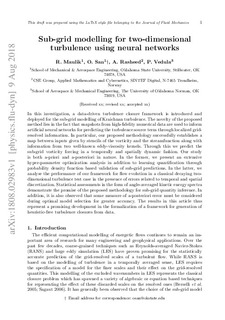| dc.contributor.author | Maulik, Romit | |
| dc.contributor.author | San, Omer | |
| dc.contributor.author | Rasheed, Adil | |
| dc.contributor.author | Vedula, Prakash | |
| dc.date.accessioned | 2018-11-27T07:08:21Z | |
| dc.date.available | 2018-11-27T07:08:21Z | |
| dc.date.created | 2018-11-25T17:42:26Z | |
| dc.date.issued | 2019 | |
| dc.identifier.citation | Journal of Fluid Mechanics. 2019, 858 122-144. | nb_NO |
| dc.identifier.issn | 0022-1120 | |
| dc.identifier.uri | http://hdl.handle.net/11250/2574935 | |
| dc.description.abstract | In this investigation, a data-driven turbulence closure framework is introduced and deployed for the subgrid modelling of Kraichnan turbulence. The novelty of the proposed method lies in the fact that snapshots from high-fidelity numerical data are used to inform artificial neural networks for predicting the turbulence source term through localized grid-resolved information. In particular, our proposed methodology successfully establishes a map between inputs given by stencils of the vorticity and the streamfunction along with information from two well-known eddy-viscosity kernels. Through this we predict the subgrid vorticity forcing in a temporally and spatially dynamic fashion. Our study is both a priori and a posteriori in nature. In the former, we present an extensive hyper-parameter optimization analysis in addition to learning quantification through probability-density-function-based validation of subgrid predictions. In the latter, we analyse the performance of our framework for flow evolution in a classical decaying two-dimensional turbulence test case in the presence of errors related to temporal and spatial discretization. Statistical assessments in the form of angle-averaged kinetic energy spectra demonstrate the promise of the proposed methodology for subgrid quantity inference. In addition, it is also observed that some measure of a posteriori error must be considered during optimal model selection for greater accuracy. The results in this article thus represent a promising development in the formalization of a framework for generation of heuristic-free turbulence closures from data. | nb_NO |
| dc.description.abstract | Subgrid modelling for two-dimensional turbulence using neural networks | nb_NO |
| dc.language.iso | eng | nb_NO |
| dc.relation.uri | https://www.cambridge.org/core/journals/journal-of-fluid-mechanics/article/subgrid-modelling-for-twodimensional-turbulence-using-neural-networks/10EDED1AEAA52C35F3E3A3BB6DC218C1 | |
| dc.title | Subgrid modelling for two-dimensional turbulence using neural networks | nb_NO |
| dc.title.alternative | Subgrid modelling for two-dimensional turbulence using neural networks | nb_NO |
| dc.type | Journal article | nb_NO |
| dc.type | Peer reviewed | nb_NO |
| dc.description.version | submittedVersion | nb_NO |
| dc.source.pagenumber | 122-144 | nb_NO |
| dc.source.volume | 858 | nb_NO |
| dc.source.journal | Journal of Fluid Mechanics | nb_NO |
| dc.identifier.doi | 10.1017/jfm.2018.770 | |
| dc.identifier.cristin | 1634695 | |
| dc.relation.project | Norges forskningsråd: 268044 | nb_NO |
| cristin.unitcode | 7401,90,11,0 | |
| cristin.unitname | Anvendt matematikk | |
| cristin.ispublished | true | |
| cristin.fulltext | preprint | |
| cristin.qualitycode | 2 | |
